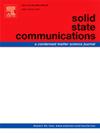Vacancy-induced localized modes and impurity band formation in the Haldane model: A quantum dot analogy
IF 2.1
4区 物理与天体物理
Q3 PHYSICS, CONDENSED MATTER
引用次数: 0
Abstract
In this study, the Haldane model’s edge states are utilized to illustrate that a zero-energy localized state forms around a single vacancy in the model. In order to complete this task, the conventional unit cell associated to the Haldane hexagonal structure is transferred onto a two-leg ladder in momentum space, effectively forming an extended Su–Schrieffer–Heeger (SSH) lattice through a one-dimensional Fourier transform. Through the application of a suitable unitary transformation, the two-leg SSH ladder in momentum space is converted into an equivalent lattice with two distinct on-site states with different momentum that are suitable for the calculations. Ultimately, the desired zero-energy localized mode formed around the vacant-site is represented by a combination of the armchair edge states. Furthermore, the scenario involving two vacant sites is investigated and it is revealed that an effective hopping interaction exists between the localized states formed around the on-site vacancies created along a zigzag chain in the lattice. This structure can be likened to the structure of a quantum dot with two none-degenerate energy levels. Such a hopping interaction is absent for the same vacancies created on the armchair chains. Finally, it is shown that introducing vacancies periodically on the sites of a zigzag row along a finite-width ribbon with the Haldane structure leads to the emergence of an impurity band within the energy gap.
霍尔丹模型中的空位诱导局部模式和杂质带形成:量子点类比
在本研究中,利用Haldane模型的边缘态来说明在模型中单个空位周围形成零能量局域态。为了完成这项任务,将与Haldane六边形结构相关的传统单元胞转移到动量空间的两腿阶梯上,通过一维傅里叶变换有效地形成扩展的Su-Schrieffer-Heeger (SSH)晶格。通过适当的幺正变换,将动量空间中的两腿SSH阶梯转化为具有适合计算的两种不同动量的不同现场状态的等效晶格。最终,在空位周围形成的期望的零能量局域模式由扶手椅边缘状态的组合来表示。此外,研究了两个空位的情况,揭示了在晶格中沿之字形链形成的空位周围形成的局域态之间存在有效的跳跃相互作用。这种结构可以比作具有两个非简并能级的量子点的结构。这种跳跃的相互作用在扶手椅链上创造的相同空位上是不存在的。最后,研究表明,在霍尔丹结构的有限宽度带上,在之字形排列的位置周期性地引入空位,会导致在能隙内出现杂质带。
本文章由计算机程序翻译,如有差异,请以英文原文为准。
求助全文
约1分钟内获得全文
求助全文
来源期刊

Solid State Communications
物理-物理:凝聚态物理
CiteScore
3.40
自引率
4.80%
发文量
287
审稿时长
51 days
期刊介绍:
Solid State Communications is an international medium for the publication of short communications and original research articles on significant developments in condensed matter science, giving scientists immediate access to important, recently completed work. The journal publishes original experimental and theoretical research on the physical and chemical properties of solids and other condensed systems and also on their preparation. The submission of manuscripts reporting research on the basic physics of materials science and devices, as well as of state-of-the-art microstructures and nanostructures, is encouraged.
A coherent quantitative treatment emphasizing new physics is expected rather than a simple accumulation of experimental data. Consistent with these aims, the short communications should be kept concise and short, usually not longer than six printed pages. The number of figures and tables should also be kept to a minimum. Solid State Communications now also welcomes original research articles without length restrictions.
The Fast-Track section of Solid State Communications is the venue for very rapid publication of short communications on significant developments in condensed matter science. The goal is to offer the broad condensed matter community quick and immediate access to publish recently completed papers in research areas that are rapidly evolving and in which there are developments with great potential impact.
 求助内容:
求助内容: 应助结果提醒方式:
应助结果提醒方式:


